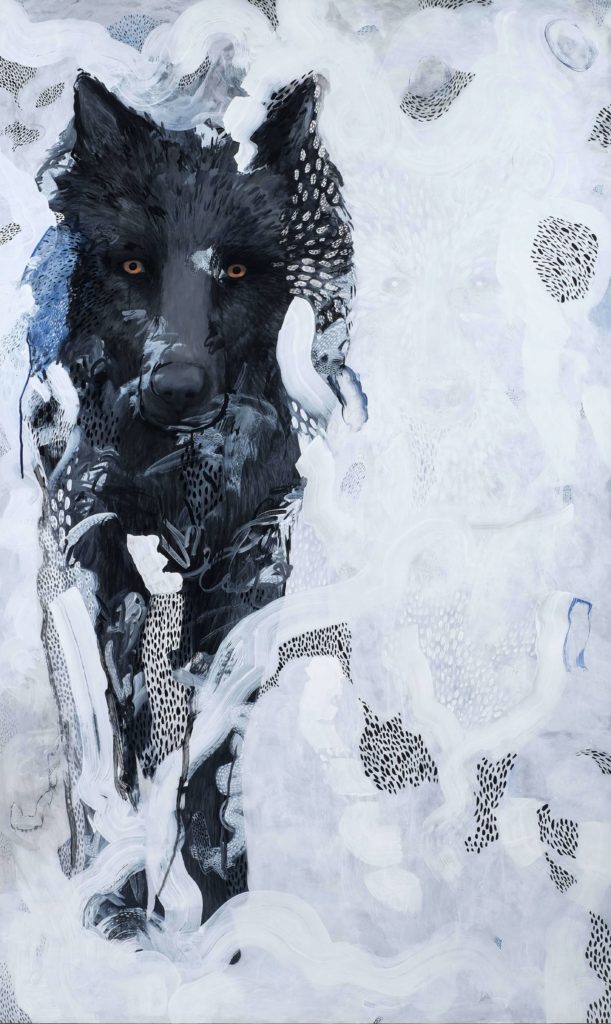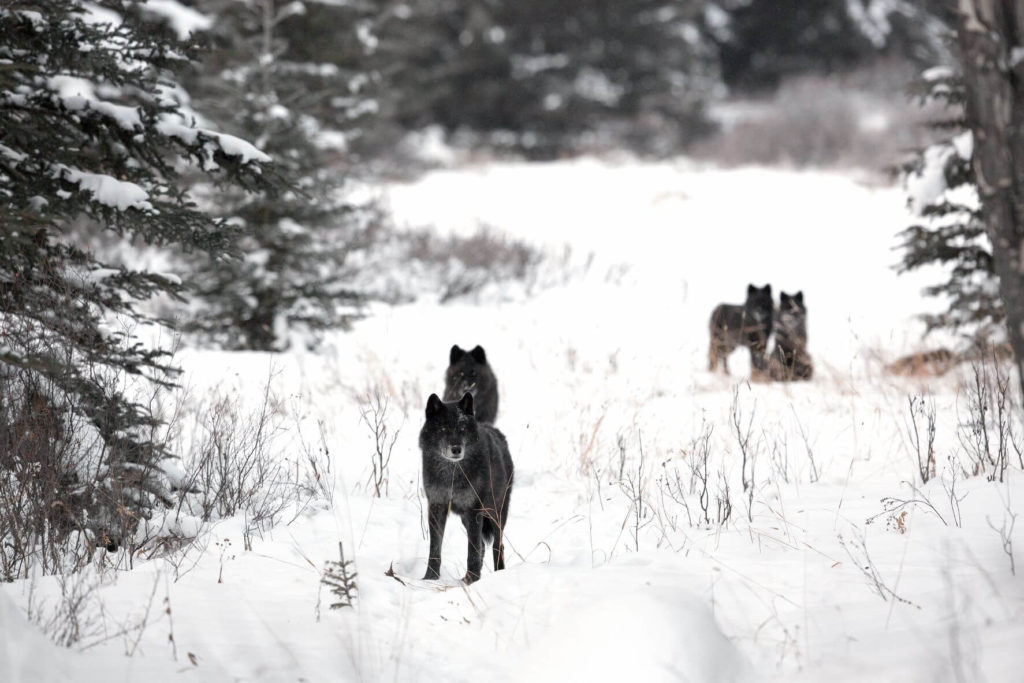
British Columbia claims its wolf cull is humane: is it?
The Government of British Columbia hires contractors to shoot wolves from helicopters. Should the public trust the government when it says this is humane?
November 8, 2022
The Government of British Columbia is set to kill more wolves this winter as part of its caribou recovery program, using methods it claims are “humane”. In the winter of 2021-2022, 279 wolves were killed through aerial gunning, where government contractors track and shoot wolves from helicopters. An additional seven cougars were killed by contractors using ground-based hunting. This past winter’s predator killing program came at a cost of $1.75 million to BC taxpayers.
The wolf cull is taking place in part because destructive industry practices like logging and oil and gas development disrupt caribou habitat, causing population declines to these ungulate species, listed as threatened under the federal Species At Risk Act. To combat this, the province has made wolves the scapegoats, where they have become the targets of an annual killing program. Hundreds of wolves are killed every winter by government-hired contractors in an attempt to protect caribou, while human and industrial activities – the root causes of caribou declines – are allowed to continue in sensitive caribou habitats.
There has been extensive research into the various dimensions of the wolf cull and caribou recovery, click here and visit the ‘further reading’ section to learn more. But there has been less focus on the government’s claim that shooting wolves from helicopters is humane. This article will examine that claim.
The province asserts killing wolves is humane
In 2019, the Ministry of Forests (formerly FLNRORD) published the Interim Aerial Wolf Reduction Procedure (2021) to outline the purpose and procedures for the wolf cull. It writes that, “This procedure focuses on the reduction of wolf populations through aerial shooting, which is deemed humane and a proven effective method for wolf reduction to support caribou recovery in B.C.” (emphasis added). It further writes that the Ministry of Forests and Ministry of Environment have a responsibility to, “Ensure methods of wolf reduction are humane and consistent with current guidelines for euthanasia of wildlife. Provide monitoring to ensure guidelines and standards are followed.”
In its 2021 citizen engagement for predator reduction, the province also made the claim that shooting wolves from helicopters is a humane method in an FAQ created for the public.
Deemed humane, but left undefined
The word “humane” is not defined in the procedure document, nor is there any legal definition in BC’s Wildlife Act, the Wildlife Act General Regulation, or the Hunting Regulation. The procedure document references the American Veterinary Medical Association’s (AVMA) guidelines on euthanasia, which write, “A properly placed gunshot can cause immediate insensibility and a humane death,” but go on to add, “For wildlife and other freely roaming animals, the preferred target area should be the head. It may, however, not be possible or appropriate to target the head when killing is attempted from large distances (missed shots may result in jaw fractures or other nonfatal injuries) …”.
Because the province doesn’t define the word humane but cites the AVMA guidelines in both the procedure document and the citizen engagement FAQ, it is reasonable to assume that the province is relying on this narrow interpretation of humane death as outlined above by the AVMA: a single gunshot to the head.
(A noteworthy omission in the AVMA’s guidelines for killing wildlife is that there is no mention of shooting wildlife from helicopters or other aircraft.)
What is really happening to wolves in BC’s remote wilderness
There are several problems if the province is relying on a narrow interpretation of humaneness as “a properly placed gunshot.” The messy conditions of BC’s wolf cull are a far cry from ideal conditions in an AVMA guidelines document. When specific components of the cull are examined, it’s clear that “humane” — when measured by a single gunshot — is neither practically achievable, nor does it include other harms inflicted upon wolves by government contractors:
1 Contractors chase and shoot wolves from helicopters, making it difficult to ensure an immediate death by a single gunshot to the brain. Documents obtained by The Fur-Bearers reveal that the practice of shooting wolves in BC is inconsistent with the AVMA requirement for a humane death described above. The documents from an Animal Care Application Form for the 2021-2022 wolf cull show that wolves aren’t always killed instantly, and that the province is aware of (and approves) contractors shooting wolves in areas other than their heads. As a result, wolves are shot multiple times until they finally succumb to their gunshot wounds.
2 The narrow interpretation of humane does not take into account the cruel and chaotic process of net-gunning, a procedure used by contractors to capture wolves to attach radio-collars onto them. It involves the contractors putting “multiple wraps of strong duct tape” around the mouths of the restrained wolves. The process of net-gunning falls into the Category of Invasiveness D in Canadian Council on Animal Care guidelines, which rank five categories of invasiveness: ‘A’ being the least invasive and ‘E’ causing the most severe pain and distress to animals. For more detailed information about this process, read our previous post on net-gunning here.
Not only does this process cause harm and distress to wolves, but the government also acknowledges that “few complications have been observed using this protocol.” What these complications are is not clear. The following is an excerpt from an Animal Care Application Form for the 2021-2022 wolf cull.
3 The province uses a cruel method known as the ‘Judas Wolf’. Wolves are captured and collared with GPS tracking devices. Once collared, the contractors follow the so-called ‘Judas Wolf’ in helicopters until he or she leads them to their pack. When the pack is spotted, contractors shoot the entire pack – but leave the collared wolf alive to repeat the process later. This process is detailed in our previous post here.
The province’s narrow interpretation of humane does not take into account the fact that wolves are sentient animals with the capacity to experience mental and emotional suffering and distress. Judas Wolves are left alive to witness their entire families being killed by gunfire (which is particularly cruel as wolves have strong familial and social relationships). The immediate distress, loss of family, and the resulting psychological impact of this tactic is not a factor considered by the province in its narrow interpretation of humane.
4 Directly at odds with the government’s declaration that shooting wolves from helicopters is humane is a 2016 caribou recovery report co-authored by a BC government scientist which writes, “There are no humane methods to directly reduce wolf numbers, but aerial removal is the only method of killing enough wolves (and entire packs) to reduce wolf densities with no risk of by‐catch.” The method hasn’t changed from 2016 to today: wolves were shot from helicopters then, as they are now in 2022. But what has changed is the province’s declaration that shooting wolves from helicopters is “deemed humane”.

Oversight and transparency of the wolf kills
As indicated in the procedure document, two ministries have a responsibility to ensure that methods of wolf reduction are humane and “consistent with current guidelines for euthanasia of wildlife”. Further, a condition for the permits issued to contractors writes, “The permit holder must ensure that the wildlife are treated in a humane manner and are not subjected to any unnecessary harm or suffering.” But how is the public supposed to know that the killing of wolves by contractors is being carried out “humanely”?
No reports or assessments regarding the monitoring of the humaneness of the wolf cull have been made public. The province admits that “complications” arise during the capturing of wolves, and that it can take multiple rounds of gunshot to kill wolves. These aberrations not only appear inconsistent with the guidelines referenced by the province, but the actual impact is that they result in suffering to wolves under the government’s watch. This raises questions about the oversight of the cull, how the province measures the humaneness of the killings, the extent of suffering endured by wolves, and possible animal cruelty.
In the interests of government transparency, the province needs to publish its assessments of the contractor’s killings to demonstrate whether the contractors are meeting the conditions in their permits and the ministries are complying with their own procedures.
Is a ‘properly placed gunshot’ even humane?
Despite the issues raised above about the practical reality of capturing and shooting wolves from helicopters, there is a broader ethical issue about the Government of British Columbia using the word “humane” to describe the methods used to kill wolves. The word humane carries extraordinary weight, yet it is left undefined by the province. It is a word that has a shared understanding among the public, one that runs counter to the province’s understanding. The province’s usage of this word obfuscates the cruel reality of the wolf cull and the suffering that hundreds of wolves have endured year after year at the hands of government contractors.
Merriam-Webster defines humane as “marked by compassion, sympathy, or consideration for humans or animals”. It’s uncontroversial to suggest that most people would agree with this definition. It’s controversial to suggest that shooting wolves from helicopters meets this definition – even if they are “properly placed gunshots”.
We are forming a more complete picture of what is happening to wolves in British Columbia. There are many words to describe it, but humane is the last one that comes to mind.
Take action to end the wolf cull!
We urge all British Columbians to contact their MLAs and call for an end to the wolf cull. For more information and what you can include in your communication to your MLA, visit our wolf cull landing page here.
Header image courtesy of Sarah Ronald. Sarah is a mixed media animal artist based in British Columbia. View her work at www.sarahronald.com and on Instagram at @sarahronaldartist.

